LZ 127Graf Zeppelin
| LZ 127Graf Zeppelin | |
|---|---|
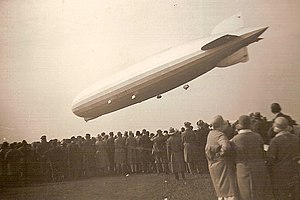
| |
| Role | Commercial passenger airship |
| National origin | Germany |
| Manufacturer | Luftschiffbau Zeppelin |
| Designer | Ludwig Dürr |
| First flight | 18 September 1928 |
| Introduction | 11 October 1928 |
| Retired | 18 June 1937 |
| Status | Scrapped March 1940 |
| Career | |
| Construction number | LZ 127 |
| Registration | D-LZ 127 |
| Radio code | DENNE[1] |
| Owners and operators | Deutsche Luftschiffahrts-Aktiengesellschaft;from 1935,Deutsche Zeppelin Reederei |
| Flights | 590 |
| Total hours | 17,177 |
| Total distance | 1.7 million km (1.06 million miles) |
LZ 127Graf Zeppelin(Deutsches Luftschiff Zeppelin 127) was a German passenger-carryinghydrogen-filledrigid airshipthat flew from 1928 to 1937. It offered the first commercialtransatlantic passenger flightservice. The ship was named after the German airship pioneerFerdinand von Zeppelin,a count (Graf) in the German nobility. It was conceived and operated byHugo Eckener,the chairman ofLuftschiffbau Zeppelin.
Graf Zeppelinmade 590 flights totalling almost 1.7 million kilometres (over 1 million miles). It was operated by a crew of 36, and could carry 24 passengers. It was the longest and largest airship in the world when it was built. It made the first circumnavigation of the world by airship, and the first nonstop crossing of the Pacific Ocean by air; its range was enhanced by its use ofBlau gasas a fuel. It was built using funds raised by public subscription and from the German government, and its operating costs were offset by the sale of specialpostage stampstocollectors,the support of the newspaper magnateWilliam Randolph Hearst,and cargo and passenger receipts.
After several long flights between 1928 and 1932, including one to theArctic,Graf Zeppelinprovided a commercial passenger and mail service between Germany and Brazil for five years. When theNazi Partycame to power, theGraf Zeppelinwas used as a propaganda tool. The airship was withdrawn from service after theHindenburg disasterin 1937, and scrapped for military aircraft production in April, 1940.
Background
[edit]The first successful flight of arigid airship,Ferdinand von Zeppelin'sLZ1,was in Germany in 1900.[2]Between 1910 and 1914, Deutsche Luftschiffahrts-Aktiengesellschaft (DELAG) transported thousands of passengers by airship.[3][4]During World War I, Germanyused airships to bomb London and other strategic targets.[5]In 1917, the GermanLZ 104 (L 59)was the first airship to make an intercontinental flight, fromJambolin Bulgaria toKhartoumand back, a nonstop journey of 6,800 kilometres (4,200 mi; 3,700 nmi).[6][7][nb 1]
During and just after the war, Britain and the United States built airships, and France and Italy experimented with confiscated German ones. In July 1919 the BritishR34flew fromEast Fortunein Scotland to New York and back.[8][nb 2]Luftschiffbau ZeppelindeliveredLZ 126to theUS Navyas awar reparationin October 1924. The company chairmanHugo Eckenercommanded the delivery flight, and the ship was commissioned as theUSSLos Angeles(ZR-3).[10][11]
TheTreaty of Versaillesplaced limits on German aviation which theAlliesrelaxed in 1925. Eckener saw an opportunity to start an intercontinental air passenger service,[12]and began lobbying the government for funds and permission to build a new civil airship.[13]Public subscription raised 2.5 millionℛ︁ℳ︁(the equivalent ofUS$600,000 at the time,[14]or $11 million in 2018 dollars[15]), and the government granted over 1 million ℛ︁ℳ︁ ($4 million).[16][17]
Design and operation
[edit]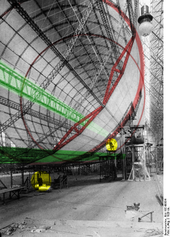
The LZ 127 was designed byLudwig Dürr[18][19]as a "stretched" version of the zeppelin LZ 126 rechristened theUSSLos Angeles).[20]It was intended from the beginning as a technology demonstrator for the more capable airships that would follow.[21]It was built between 1926 and September 1928 at the Luftschiffbau Zeppelin works inFriedrichshafen,onLake Constance,Germany, which became its home port for nearly all of its flights. Itsduraluminframe was made of eighteen 28-sided structural polygons joined lengthwise with 16 km (10 mi) of girders and braced with steel wire. The outer cover was of thickcotton,painted withaircraft dopecontaining aluminium to reduce solar heating, then sandpapered smooth. The gas cells were also cotton, lined withgoldbeater's skins,and protected from damage by a layer containing 27 km (17 mi) oframiefibre.[20][22]
Graf Zeppelinwas 236.6 m (776 ft) long and had a total gas volume of 105,000 m3(3,700,000 cu ft), of which 75,000 m3(2,600,000 cu ft) was hydrogen carried in 17lifting gascells (Traggaszelle), and 30,000 m3(1,100,000 cu ft) wasBlau gasin 12 fuel gas cells (Kraftgaszelle).[nb 3]TheGraf Zeppelinwas built to be the largest possible airship that could fit into the company's construction hangar,[27][28]with only 46 cm (18 in) between the top of the finished vessel and the hangar roof.[29]It was the longest and most voluminous airship when built,[26][30][nb 4]but it was too slender for optimum aerodynamic efficiency,[31][32]and there were worries that the shape would compromise its strength.[33]
Graf Zeppelinwas powered by fiveMaybach VL II12-cylinder 410 kW (550 hp) engines, each of 33.251 L (2,029.1 cu in) capacity, mounted in individual streamlinednacelles[nb 5]arranged so that each was in an undisturbed airflow.[35]The engines were reversible,[36]and were monitored by crew members who accessed them during flight via open ladders.[32]The two-bladed woodenpusher propellerswere 3.4 m (11 ft) in diameter,[37]and were later upgraded to four-bladed units.[32]On longer flights, theGraf Zeppelinoften flew with one engine shut down to conserve fuel.[38]
Graf Zeppelinwas the only rigid airship to burnBlau gas;[39][40]the engines were started onpetrol[nb 6]and could then switch fuel.[24]A liquid-fuelled airship loses weight as it burns fuel, requiring the release of lifting gas, or thecapture of water from exhaust gas or rainfall,to avoid the vessel climbing. Blau gas was only slightly heavier than air, so burning it had little effect on buoyancy.[42][43]On a typical transatlantic journey, theGraf Zeppelinused Blau gas 90% of the time, only burning petrol if the ship was too heavy, and used ten times less hydrogen per day than the smaller zeppelinL 59did on itsKhartoumflight in 1917.[44][nb 7]
Graf Zeppelintypically carried 3,500 kg (7,700 lb) ofballastwater and 650 kg (1,430 lb) of spare parts, including an extra propeller.[45]Calcium chloridewas added to the ballast water to prevent freezing. The ship retainedgrey waterfrom the sinks for use as additional ballast.[46]Both fresh and waste water could be moved forward and aft to control trim.[47]

The airship usually took off vertically using static lift (buoyancy), then started the engines in the air, addingaerodynamic lift.[48]Normal cruising altitude was 200 m (650 ft); it climbed if necessary to cross high ground or poor weather, and often descended in stormy weather.[49]To measure the wind speed over the sea, and calculate drift, floating pyrotechnicflareswere dropped.[50]
When preparing to land, the crew advised the ground either by radio orsignal flag.Ground crew lit a smoky fire to help the airshipmen judge wind speed and direction. The airship slowed, then adjusted buoyancy to neutral by valving off hydrogen or dropping ballast.Echo soundingwith the report from an 11-mmblank roundwas used to measure altitude accurately.[51][52][nb 8]The ship flew in with its nose trimmed slightly down, made itsfinal approachinto the wind descending at 30 m (100 ft) per minute, then usedreverse thrustto stop over the landing flag, where it dropped ropes to the ground. Landing in rough weather required a faster approach.[54][55]Up to 300 people manhandled the airship into a hangar or secured it by the nose to a mooring mast.[56][57]
Graf Zeppelin's top airspeed was 128 km/h (36 m/s; 80 mph; 69 kn) at 1,980 kW (2,650 hp); it cruised at 117 km/h (33 m/s; 73 mph; 63 kn), at 1,600 kW (2,150 hp). It had a total lift capacity of 87,000 kg (192,000 lb) with a usablepayloadof 15,000 kg (33,000 lb) on a 10,000 km (6,200 mi; 5,400 nmi) flight.[28]It was slightly unstable inyaw,[58]and to make it easier to fly, had anautomatic pilotwhich stabilised it in that axis.[53]Pitch was controlled manually by an elevatorman who tried to limit the angle to 5° up or down, so as not to upset the bottles of wine which accompanied the elaborate food served on board.[59]Operating the elevators was so demanding and strenuous that an elevatorman's shift was only four hours, reduced to two in rough weather.[59]
Layout
[edit]
The operational spaces, common areas, and passenger cabins were built into a gondola structure in the forward part of the airship's ventral surface, with the flight deck well forward in a "chin" position.[60]The gondola was 30 metres (98 ft) long and 6 metres (20 ft) wide;[61]its streamlined design reflected contemporary aesthetics,[62][63]minimised overall height, and reduceddrag.[39]Behind the flight deck was the map room, with two large hatches to allow the command crew to communicate with the navigators, who could take readings with asextantthrough the two large windows.[32]There was also a radio room and agalleywith a double electric oven and hot plates.[64]

The galley staff served three hot meals a day in the main dining and sitting room, which was 5 metres (16 ft) square.[65]It had four large arched windows, wooden inlays, andArt Deco-upholstered furniture.[63][66]Between meals, the passengers could socialise and look at the scenery. On the round-the-world flight, there was dancing to aphonograph,fine wine, andErnst Lehmann,one of the officers, played theaccordion.[67]A corridor led to ten passenger cabins capable of sleeping 24, a pair of washrooms, and dualchemical toilets.[46]The passenger cabins were set by day with a sofa, which converted at night into two beds.[68]The cabins were often cold, and on some sectors passengers wore furs and huddled under blankets to stay warm.[69]There was a noticeable smell from the Blau gas, especially when the ship was stationary.[70][71]
A ladder from the map room led up to the keel corridor inside the hull, and accommodation for the 36 crewmen. Officers' quarters were towards the nose;[72]behind them were the baggage store, the crew mess room, and the quarters for the ordinary crew, who slept in wire-frame beds with fabric screens.[51]Also along this corridor were petrol, oil and water tanks, and stowage for cargo and spare parts. Branches from the keel corridor led to the five engine nacelles, and there were ladders up to the axial corridor, just below the ship's main axis, which gave access to all the gas cells.[73]
Electrical and communications systems
[edit]
The main generating plant was in a separate compartment mostly inside the hull. Two 8.9 kW (12 hp)Wanderercar engines adapted to burn Blau gas, only one of which operated at a time, drove twoSiemens & Halskedynamos each. One dynamo on each engine powered the oven and hotplates, and one the lighting andgyrocompass.Cooling water from these engines heated radiators inside the passenger lounge.[74]Tworam air turbinesattached to the main gondola on swinging arms provided electrical power for the radio room, internal lighting, and the galley. Batteries could power essential services like radios for half an hour,[75][76]and there were small petrol generators for emergency power.[76]
Three radio operators used a one-kilowattvacuum tubetransmitter (about 140 W antenna power) to send telegrams over thelow frequency(500–3,000 m) bands.[75]A 70 W antenna power emergency transmitter carried telegraph and radio telephone signals over 300–1,300 m wavelength bands.[68][75]The main aerial consisted of twolead-weighted 120-metre (390 ft)-long wires deployed by electric motor or hand crank; the emergency aerial was a 40-metre (130 ft) wire stretched from a ring on the hull.[75]Three six-tube receivers served the wavelengths from 120 to 1,200 m (medium frequency), 400 to 4,000 m (low frequency) and 3,000 to 25,000 m (overlapping low frequency andvery low frequency).[75]The radio room also had ashortwave receiverfor 10 to 280 m (high frequency).[75]
Aradio direction finderused a loop antenna to determine the airship's bearing from any two land radio stations or ships with known positions.[68]During the first transatlantic flight in 1928, the radio room sent 484 privatetelegramsand 160 press telegrams.[75]
Operational history
[edit]
The LZ 127 was christenedGraf Zeppelinby Countess Brandenstein-Zeppelin on 8 July 1928, after her father Ferdinand von Zeppelin, the founder of the company, on the 90th anniversary of his birth.[77][78]During most of its career, it was operated by Luftschiffbau Zeppelin's commercial flight arm,DELAG,in conjunction with theHamburg-American Line(HAPAG); for its final two years it flew for theDeutsche Zeppelin Reederei(DZR).
Passengers paid premium fares to fly on theGraf Zeppelin(1,500ℛ︁ℳ︁from Germany toRio de Janeiroin 1934, equal to $590 then,[79]or $13,000 in 2018 dollars[15]), and fees collected for valuable freight and air mail also provided income. On the first transatlantic flight,Graf Zeppelincarried 66,000 postcards andcovers.[80]
Eckener had earned his doctorate inPsychologyatLeipzig UniversityunderWilhelm Wundt,[81]and could use his knowledge of mass psychology to the benefit of theGraf Zeppelin.[82]He identified safety as the most important factor in the ship's public acceptance, and was ruthless in pursuit of this.[83]He took complete responsibility for the ship, from technical matters, to finance, to arranging where it would fly next on its years-long public relations campaign, in which he promoted "zeppelin fever".[84][85]On one of the Brazil trips BritishPathé Newsfilmed on board.[86]Eckener cultivated the press, and was gratified when the British journalistLady Grace Drummond-Haywrote, and millions read, that:
TheGraf Zeppelinis a ship with a soul. You have only to fly in it to know that it's a living, vibrant, sensitive and magnificent thing.[87]
Graf Zeppelinwas greeted by large crowds on most of its early voyages. There were 100,000 at Moscow and possibly 250,000 at Tokyo to see it.[88][89]At Stockholm, spectators launched firework rockets around it, and on the return flight from Moscow it was punctured by rifle shots near the Soviet Union-Lithuania border.[90]On one visit to Rio de Janeiro people released hundreds of small toy petrol-burning hot air balloons near the flammable craft.[91]The airship captured the public imagination and was used extensively in advertising.[92]On visits to England, it photographedRoyal Air Forcebases, theBlackburn aircraftfactory in Yorkshire, and thePortsmouth naval dockyard;it is likely that this wasespionageat the behest of the German government.[93]
Proving flights
[edit]During 1928, there were six proving flights. On the fourth one, Blau gas was used for the first time.Graf ZeppelincarriedOskar von Miller,head of theDeutsches Museum;Charles E. Rosendahl,commander of USSLos Angeles;and the British airshipmen Ralph Sleigh Booth andGeorge Herbert Scott.It flew from Friedrichshafen toUlm,viaCologneand across the Netherlands toLowestoftin England, then home viaBremen,Hamburg,Berlin,LeipzigandDresden,a total of 3,140 kilometres (1,950 mi; 1,700 nmi) in 34 hours and 30 minutes.[94]On the fifth flight, Eckener caused a minor controversy by flying close toHuis Doornin the Netherlands, which some interpreted as a gesture of support for the formerKaiser Wilhelm IIwho was living in exile there.[95][96]
First intercontinental flight (1928)
[edit]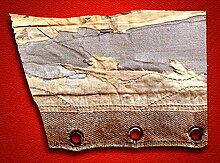
In October 1928,Graf Zeppelinmade its first intercontinental trip, toLakehurst Naval Air Station,New Jersey, US, with Eckener in command and Lehmann as first officer.[nb 9]Rosendahl and Drummond-Hay flew the outward leg.[98][80]Ludwig DettmannandTheo Matejkomade an artistic record of the flight.[99]
On the third day of the flight, a large section of the fabric covering of the port tail fin was damaged while passing through a mid-oceansquall line,[100]and volunteer riggers (including Eckener's son, Knut) climbed outside the airship and made repairs to the torn fabric. Eckener directed Rosendahl to make adistress call;when this was received, and nothing else was heard from the airship, many believed it was lost.[101]After the ship arrived safely, there was some annoyance from the Lakehurst personnel that the Zeppelin had not answered repeated calls for its position and estimated arrival time. Eckener explained that because the airship was forced to fly at a reduced speed due to the damaged fin, the wind-driven generator could not generate enough power to send messages.[102]The 9,926 km (6,168 mi; 5,360 nmi) crossing, the longest non-stop flight at the time, had taken 111 hours 44 minutes.[103]
Clara Adamsbecame the first female paying passenger to fly transatlantic on the return flight.[104]The ship endured an overnight gale that blew it backwards in the air and 320 km (200 mi; 170 nmi) off course, to the coast ofNewfoundland.[105]Astowawayboarded at Lakehurst and was discovered in the mail room mid-voyage.[106][107]The airship returned home and on 6 November flew to BerlinStaaken,where it was met by the German president,Paul von Hindenburg.[108]
Mediterranean flights (1929)
[edit]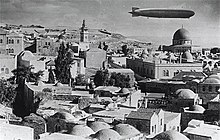
Graf Zeppelinvisited Palestine in late March 1929. At Rome it sent greetings toBenito Mussoliniand KingVictor Emmanuel III.It enteredPalestine,flew overTel AvivandJerusalem,and descended to near the surface of theDead Sea,430 m (1,400 ft) below sea level. The ship delivered 16,000 letters in mail drops atJaffa,Athens,BudapestandVienna.[109]The Egyptian government (under pressure from Britain) refused it permission to enter their airspace.[110]The second Mediterranean cruise flew over France, Spain, Portugal andTangier,[111]then returned home viaCannesandLyonon 23–25 April.[112][113]
Forced landing in France (1929)
[edit]
On 16 May 1929, on the first night of its second trip to the US,Graf Zeppelinlost four of its engines.[114]With Eckener struggling for a suitable place to force-land, the French Air Ministry allowed him to land atCuers-Pierrefeu,nearToulon.[115]Barely able to control the ship, Eckener made an emergency landing.[116]The incident, and the forced comradeship it engendered, softened France's attitude to Germany and its airships slightly.[117]The incident was caused by adjustments that had been made by the chief engineer to the four engines that failed.[118][119]
On 4 August, the airship made it to Lakehurst on the second attempt. Aboard was Susie, aneastern gorillawho had been captured nearLake Kivuin theBelgian Congoand sold by her German owner to an American dealer.[120][121]
Round-the-world flight (1929)
[edit]
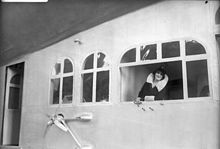
American newspaper publisherWilliam Randolph Hearst's media empire paid half the cost of the project to flyGraf Zeppelinaround the world,[122]with four staff on the flight;Lady Hay Drummond-Hay,Karl von Wiegand,Australian explorerHubert Wilkins,and cameraman Robert Hartmann. Drummond-Hay became the first woman to circumnavigate the world by air.[123][nb 10] Hearst stipulated that the flight in August 1929 officially start and finish at Lakehurst.[125][126]Round-the-world tickets were sold for almost $3000 (equivalent to $53,000 in 2023),[15]but most participants had their costs paid for them.[127]The flight's expenses were offset by the carriage of souvenir mail between Lakehurst, Friedrichshafen,Tokyo,and Los Angeles.[122]A US franked letter flown on the whole trip from Lakehurst to Lakehurst required $3.55 (equivalent to $63 in 2023)[15]in postage.
Graf Zeppelinset off from Lakehurst on 8 August, heading eastwards.[128]The ship refuelled at Friedrichshafen, then continued across Eastern Europe and the Soviet Union to Tokyo. After five days at a former German airship shed that had been removed fromJüterbogand rebuilt atKasumigaura Naval Air Station,[129][130]Graf Zeppelincontinued across the Pacific to California. Eckener delayed crossing the coast at San Francisco'sGolden Gateso as to come in near sunset for aesthetic effect.[131][132]The ship landed atMines Fieldin Los Angeles, completing the first ever nonstop flight across the Pacific Ocean.[133][134]The takeoff from Los Angeles was difficult because of high temperatures and aninversion layer.To lighten the ship, six crew and some cargo were sent on to Lakehurst by aeroplane.[135]The airship suffered minor damage from atail strikeand barely cleared electricity cables at the edge of the field.[32][136]TheGraf Zeppelinarrived back at Lakehurst from the west on the morning of 29 August, three weeks after it had departed to the east.
Flying time for the four Lakehurst to Lakehurst legs was 12 days, 12 hours, and 13 minutes; the entire circumnavigation (including stops) took 21 days, 5 hours, and 31 minutes to cover 33,234 km (20,651 mi; 17,945 nmi).[132][137]It was the fastestcircumnavigationof the globe at the time.[138]
Eckener became the tenth recipient and the third aviator to be awarded the Gold Medal of theNational Geographic Society,which he received on 27 March 1930 at the Washington Auditorium.[139]Before returning to Germany, Eckener met PresidentHerbert Hoover,and successfully lobbied the US Postmaster General for a special three-stamp issue (C-13, 14 & 15) for mail to be carried on the Europe-Pan American flight due to leave Germany in mid-May.[140][141]Germany issued a commemorative coin celebrating the circumnavigation.[126]
Europe-Pan American flight (1930)
[edit]
On 26 April 1930,Graf Zeppelinflew low over theFA Cup FinalatWembley Stadiumin England, dipping in salute to KingGeorge V,then briefly moored alongside the largerR100atCardington.[55]On 18 May, it left on a triangular flight between Spain, Brazil, and the US, carrying 38 passengers, many of them in crew accommodation.[135]The ship arrived atRecife(Pernambuco) in Brazil, docking at Campo do Jiquiá on 22 May, where 300 soldiers helped land it.[142][143]It then flew toRio de Janeiro,where there was no post to tether to, so it was held down by the landing party for the two hours of the visit.[142][144]
During the flight north via Recife to Lakehurst, a storm damaged the rear engine nacelle, which was repaired in the hangar at Lakehurst. During ground handling of the airship there, it suddenly lifted, causing serious injury to one of theUS Marineswho was assisting.[145]A few hours from home, when theGraf Zeppelinflew through a heavyhailstormover theSaône,the envelope was damaged and the ship lost lift. Eckener ordered full power and flew the ship out of trouble, but it came within 200 feet of hitting the ground.[146][147]
The Europe-Pan American flight was largely funded by the sale of special stamps issued by Spain, Brazil, and the US for franking mail carried on the trip. The US issuedstamps in three denominations:65¢, $1.30, and $2.60, all on 19 April 1930.[148]
Middle East flight (1931)
[edit]The second flight to the Middle East took place in 1931, beginning on 9 April.Graf Zeppelincrossed the Mediterranean toBenghaziin Libya, then flew viaAlexandria,toCairoin Egypt, where it saluted King Fuad at the Qubbah Palace, then visited theGreat Pyramid of Gizaand hovered 70 feet above the top of the monument.[110]After a brief stop, the ship flew to Palestine where it circled Jerusalem, then returned to Cairo to pick up Eckener, who had stayed for an audience with the King. It returned to Friedrichshafen on 13 April.[110]
Polar flight (1931)
[edit]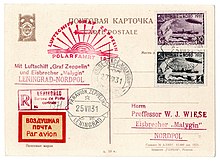

The polar flight (Polarfahrt 1931) lasted from 24 to 31 July 1931. The ship rendezvoused with theSoviet icebreakerMalygin,which had Italian polar explorerUmberto Nobileaboard. It exchanged 120 kg (260 lb) of souvenir mail with the airship, which Eckener landed on theArctic Ocean.[149]Fifty thousand cards and letters, weighing 300 kg (660 lb), were carried. The costs of the expedition were met largely by the sale of special postage stamps issued by Germany and the Soviet Union tofrankthe mail carried on the flight.[150][151]
WriterArthur Koestlerwas one of two journalists on board, along with a multinational team of scientists led by Soviet Professor Samoilowich, who measured theEarth's magnetic field,and a Soviet radio operator.[152][153]The expedition photographed and mappedFranz Josef Landaccurately for the first time, and came within 910 kilometres (570 mi; 490 nmi) of theNorth Pole.[154]It deployed three earlyradiosondesover the Arctic to collect meteorological data from the upper atmosphere.[155]
South American operations (1931–1937)
[edit]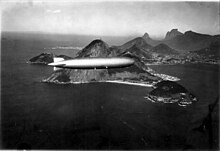
From the beginning, Luftschiffbau Zeppelin had plans to serve South America.[156][157]There was a large community ofGermans in Brazil,and existing sea connections were slow and uncomfortable.[158]Graf Zeppelincould transport passengers over long distances in the same luxury as an ocean liner, and almost as quickly as contemporaryairliners.[159]
Graf Zeppelinmade three trips to Brazil in 1931[160]and nine in 1932.[161]The route to Brazil meant flying down the Rhône valley in France, a cause of great sensitivity between the wars. The French government, concerned about espionage, restricted it to a 12 nmi (22 km; 14 mi)-wide corridor in 1934.Graf Zeppelinwas too small and slow for the stormy North Atlantic route,[162][163]but because of the Blau gas fuel, could carry out the longer South Atlantic service.[44]On 2 July 1932 it flew a 24-hour tour of Britain.[105]

While returning from Brazil in October 1933,Graf Zeppelinstopped atNAS Opa Lockain Miami, Florida, and thenAkron, Ohio,where it moored at theGoodyear Zeppelin airdock.[165]The airship then appeared at theCentury of ProgressWorld's Fair in Chicago.[166]It displayedswastikamarkings on the left side of the fins, as theNazi Partyhadtaken power in January.Eckener circled the fair clockwise so that the swastikas would not be seen by the spectators.[153][167]TheUnited States Post Office Departmentissued a special 50-cent airmail stamp (C-18) for the visit, which was the fifth and final one the ship made to the US.[168]

The airship's cotton envelope absorbed moisture from the air in humid tropical conditions. When therelative humidityreached 90%, the ship's weight rose by almost 1,800 kilograms (4,000 lb).[169]Exposure to tropical downpours could greatly add to this, but when under way the ship had enough reserve power to generate dynamic lift to compensate.[170]In April 1935 it made a rough forced landing at Recife after it was caught in a rainstorm at low speed on theapproach to landand the added weight of several tons of water caused it to sink to the ground. The lower rudder was lost, the outer envelope was ripped in several places, and a petrol tank was punctured by a palm tree.[91][171]

In late 1935Graf Zeppelinoperated a temporarypostal shuttle servicebetween Recife andBathurst,in the British Africancolony of the Gambia.On 24 November, during the second trip, the crew learned of an insurrection in Brazil, and there was some doubt whether it would be possible to return to Recife.Graf Zeppelindelivered its mail toMaceió,then loitered off the coast for three days until it was safe to land, after a flight of 118 hours and 40 minutes.[172]

Brazil built a hangar for airships atBartolomeu de Gusmão Airport,near Rio de Janeiro, at a cost of $1 million (equivalent to $22 million in 2018[15]). Brazil charged the DZR $2000 ($44,000[15]) per landing, and had agreed that German airships would land there 20 times per year, to pay off the cost.[173]The hangar was constructed in Germany and the parts were transported and assembled on site. It was finished in late 1936,[174]and was used four times byGraf Zeppelinand five byHindenburg.[175]It now houses units of theBrazilian Air Force.[174]
Graf Zeppelinmade 64 round trips to Brazil, on the first regular intercontinental commercial air passenger service,[176]and it continued until theloss of theHindenburgin May 1937.[175]
Propaganda (1936)
[edit]Eckener was outspoken about his dislike of the Nazi Party, and was warned about it byRudolf Diels,the head of theGestapo.[177][178]When the Nazis gained power in 1933,Joseph Goebbels(Reich Minister of Propaganda) andHermann Göring(Commander-in-chief of the Luftwaffe) sidelined Eckener by putting the more sympathetic Lehmann in charge of a new airline,Deutsche Zeppelin Reederei(DZR), which operated German airships.[179]
On 7 March 1936, in violation of the Treaty of Versailles and theLocarno Treaties,German troopsreoccupied the Rhineland.Hitler called aplebiscite for 29 Marchto retrospectively approve the reoccupation, and adopt a list of exclusively Nazi candidates to sit in the newReichstag.Goebbels commandeeredGraf Zeppelinand the newly launchedHindenburgfor the ReichMinistry of Public Enlightenment and Propaganda.[180]The airships flew in tandem around Germany before the vote, with a joint departure from Löwenthal on the morning of 26 March.[181]They toured the country for four days and three nights, dropping propaganda leaflets, playing martial music and slogans from large loudspeakers, and broadcasting political speeches from a makeshift radio studio onHindenburg.[182]
Retirement and aftermath
[edit]
The crew heard of theHindenburgdisaster by radio on 6 May 1937 while in the air, returning from Brazil to Germany; they delayed telling the passengers until after landing on 8 May so as not to alarm them.[183][184]The disaster, in which Lehmann and 35 others were killed, destroyed public faith in the safety of hydrogen-filled airships, making continued passenger operations impossible unless they could convert to non-flammablehelium.Hindenburghad originally been planned to use helium,[185][186]but almost all of the world's supply was controlled by the US, and its export had been tightly restricted by theHelium Act of 1925.[187]
Graf Zeppelinwas permanently withdrawn from service shortly after the disaster.[188][189]On 18 June, its 590th and last flight took it to Frankfurt am Main, where it was deflated and exhibited to visitors in its hangar.[178][190]President Rooseveltsupported exporting enough helium for theHindenburg-classLZ 130Graf Zeppelin IIto resume commercial transatlantic passenger service by 1939,[191]but by early 1938, the opposition ofInterior SecretaryHarold Ickes,who was concerned that Germany was likely to use the airship in war, made that impossible.[192][193]On 11 May 1938, Roosevelt's press secretary announced that the US would not sell helium to Germany. Eckener, who had unsuccessfully intervened, responded that it would be "the death sentence for commercial lighter-than-air craft."[192][193]Graf Zeppelin IImade 30 test, promotional, propaganda and military surveillance flights around Europe using hydrogen between September 1938 and August 1939; it never entered commercial passenger service. On 4 March 1940, Göring orderedGraf ZeppelinandGraf Zeppelin IIto be scrapped, and their airframes to be melted down for the German military aircraft industry.[194]
During its career,Graf Zeppelinhad flown almost 1.7 million km (1,053,391 miles), the first aircraft to fly over a million miles. It made 144 oceanic crossings (143 across the Atlantic, and one of the Pacific), carried 13,110 passengers and 106,700 kg (235,300 lb) of mail and freight.[195]It flew for 17,177 hours (717 days, or nearly two years),[72]without injuring a passenger or crewman.[196]It has been called "the world's most successful airship",[78][197]but it was not a commercial success; it had been hoped that theHindenburg-class airshipsthat followed would have the capacity and speed to make money on the popular North Atlantic route.[198]Graf Zeppelin's achievements showed that this was technically possible.[78]
By the time the twoGraf Zeppelins were recycled, they were the last rigid airships in the world,[199]and heavier-than-air long-distance passenger transport, using aircraft like theFocke-Wulf Condorand theBoeing 307 Stratoliner,was already in its ascendancy.[200]Aeroplanes were faster, less labour-intensive and safer;[201][202]by 1958 they developed into passenger jets like theBoeing 707which could cross the Atlantic reliably in a few hours. By 2017 annual air passenger journeys had surpassed 4 billion.[203]
Modern airships like theZeppelin NTusesemi-rigid designs,and are lifted by helium on their mainly sight-seeing duties.[204]
Specifications
[edit]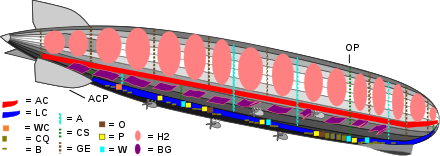
Data from[205]
General characteristics
- Crew:36
- Capacity:20 passengers / Typical disposable load 19,900 kg (43,900 lb)
- Length:236.6 m (776 ft 3 in)
- Diameter:30.5 m (100 ft 1 in) maximum
- Fineness ratio:7.25
- Height:33.5 m (109 ft 11 in)
- Volume:75,000 m3(2,600,000 cu ft)hydrogen+ 30,000 m3(1,100,000 cu ft)Blau gascapacity
- Number of gas cells:16
- Empty weight:67,100 kg (147,930 lb)
- Fuel capacity:8,000 kg (18,000 lb) petrol + 30,000 m3(1,100,000 cu ft) Blau gas
- Useful lift:87,000 kg (192,000 lb) typical gross lift
- Powerplant:5 ×Maybach VL IIV-12 water-cooled reversible piston engines, 410 kW (550 hp) each
- Propellers:2, later 4-bladed propellers
Performance
- Maximum speed:128.16 km/h (79.63 mph, 69.20 kn)
- Range:10,000 km (6,200 mi, 5,400 nmi) at 117 km/h (73 mph; 63 kn)
See also
[edit]References
[edit]Notes
- ^L 59 was tasked to deliver supplies to German forcesfighting in East Africa.The mission was cancelled, and it returned to Jamboli.[6][7]
- ^In 1921 Britain'sImperial Airship Schemeaimed to connect theBritish Empireusing passenger airships.[9]
- ^Blau gas was a mixture of saturated andunsaturated hydrocarbonsand hydrogen, produced bypyrolysisoffuel oil.[23]It was about 1.05 times as heavy as air,[24]and could be substituted with a mixture ofpropaneand hydrogen.[25][26]
- ^Its volume record was beaten by the British airshipR101in October 1929, and its length byUSSAkronin 1931.
- ^One of the nacelles is preserved and displayed atZeppelin Museum Friedrichshafen.[34]
- ^The liquid fuel used was a blend of commercial petrol andbenzole.[41]
- ^The amount of Blau gas the airship carried could power it for 100 hours; if the ship had had all-hydrogen gas cells and the extra lift had been used to carry petrol, it could have run for only 67.[20]
- ^This was later replaced by a device using compressed air to produce a burst ofultrasound,which was less disturbing for the passengers.[53]
- ^Lehmann commanded most ofGraf Zeppelin's flights, 272 to Eckener's 133. Four other captains commanded a total of 100 flights.[97]
- ^A semidocumentary film titledFarewellwas released in 2009 which featured much of Hartmann's newsreel footage of her. The film was later aired onBBCunder the titleAround The World by Zeppelin.[124]
Citations
- ^Lehmann (1937),p. 24.
- ^Hoyt (1969),pp. 26–27.
- ^Hoyt (1969),p. 37.
- ^Marsh, W Lockwood (3 January 1930)."Twenty-One Years of Airship Progress".Flight:87–88.
- ^Layman (1996),p. 72.
- ^abDick & Robinson (1985),pp. 74–76.
- ^abHoyt (1969),pp. 106–107.
- ^"The Transatlantic Voyage of R.34".Flight:906–912. 10 July 1919.
- ^Duggan & Meyer (2001),pp. 130, 174.
- ^Vaeth (1958),p. 40.
- ^Robinson (1975),pp. 207–213.
- ^Lindley, John M (1978)."Commercial Aviation and the Mastery of Transoceanic Flight".Naval Aviation News.Chief of Naval Operations: 36–37.
- ^Vaeth (1958),pp. 44–45.
- ^"Exchange Rates Between the United States Dollar and Forty-one Currencies".Measuring Worth.
- ^abcdef1634–1699:McCusker, J. J.(1997).How Much Is That in Real Money? A Historical Price Index for Use as a Deflator of Money Values in the Economy of the United States: Addenda et Corrigenda(PDF).American Antiquarian Society.1700–1799:McCusker, J. J.(1992).How Much Is That in Real Money? A Historical Price Index for Use as a Deflator of Money Values in the Economy of the United States(PDF).American Antiquarian Society.1800–present:Federal Reserve Bank of Minneapolis."Consumer Price Index (estimate) 1800–".Retrieved29 February2024.
- ^Robinson (1975),p. 261.
- ^"New German Airship – A visit to the works at Friedrichshafen". News.The Times.No. 44851. London. 26 March 1928. col E, p. 8.
- ^Swinfield (2013),p. 218.
- ^Hammack (2016),pp. 216, 221.
- ^abcRobinson (1975),p. 262.
- ^Lehmann (1937),pp. 253–254.
- ^Vaeth (1958),pp. 47–50.
- ^Hammack (2016),p. 235.
- ^abHammack (2016),pp. 231–232.
- ^Vaeth (1958),p. 103.
- ^abDick & Robinson (1985),p. 34.
- ^de Syon (2005),p. 128.
- ^abLehmann (1937),p. 254.
- ^Lehmann (1937),p. 47.
- ^"Ninety-year anniversary of the longest standing FAI records set by airship pilot Dr Hugo Eckener".www.fai.org.19 October 2018.
- ^Vaeth (1958),p. 47.
- ^abcdeNiderost, Eric (19 August 2019)."Globetrotting Leviathan: Graf Zeppelin's amazing voyage".Aviation History(July 1993).
- ^Vaeth (1958),pp. 65–66.
- ^"Zeppelin Museum / The Museum / The Collections / Technology Collection / Engine nacelle of the LZ 127 Graf Zeppelin".Zeppelin Museum Friedrichshafen. Archived fromthe originalon 26 April 2014.
- ^Vaeth (1958),pp. 51–52.
- ^"Maybach VL-2, V-12 Engine".National Air and Space Museum.10 March 2016.
- ^Hammack (2016),p. 225.
- ^Vaeth (1958),pp. 73, 116.
- ^abVaeth (1958),p. 51.
- ^Robinson (1975),p. 355.
- ^Hammack (2016),p. 232.
- ^"'Blue' Gas ".Naval Institute Proceedings.54.United States Naval Institute: 1096. 1928.
- ^de Syon (2005),p. 129.
- ^abDick & Robinson (1985),p. 76.
- ^Hammack (2016),p. 236.
- ^abVaeth (1958),p. 143.
- ^Dick & Robinson (1985),p. 69.
- ^Vaeth (1958),p. 52.
- ^Dick & Robinson (1985),p. 53.
- ^Lehmann (1937),pp. 263–264.
- ^abWhiting, Oliver K (28 August 1931)."My Flight from Friedrichshafen".Flight:855.
- ^Vaeth (1958),p. 144.
- ^abVaeth (1958),p. 186.
- ^Dick & Robinson (1985),p. 70.
- ^ab"Graf Zeppelin visits England"(PDF).Flight:474. 2 May 1930.
- ^de Syon (2005),p. 135.
- ^Robinson (1975),p. 263.
- ^Hammack (2016),pp. 230, 238.
- ^abcVaeth (1958),p. 187.
- ^Lehmann (1937),p. 252.
- ^Botting (1980),p. 105.
- ^de Syon (2005),pp. 132–133.
- ^abVotolato (2007),p. 182.
- ^Robinson (1975),p. 210.
- ^Botting (1980),p. 104.
- ^Vaeth (1958),pp. 187–188.
- ^Vaeth (1958),pp. 93–94.
- ^abcDick & Robinson (1985),p. 37.
- ^Vaeth (1958),p. 62.
- ^Hammack (2016),p. 219.
- ^Vaeth (1958),pp. 53–54.
- ^abRidley-Kitts (2012),p. 287.
- ^Lehmann (1937),p. 256.
- ^Hammack (2016),pp. 232–233.
- ^abcdefg"Funkverkehr auf dem Luftschiff LZ 127 Graf Zeppelin".www.seefunknetz.de.
- ^abHammack (2016),p. 233.
- ^"The New Zeppelin". News in Brief.The Times.No. 44941. London. 10 July 1928. col B, p. 15.
- ^abcBrookes (1992),p. 9.
- ^"Exchange Rates Between the United States Dollar and Forty-one Currencies".MeasuringWorth.com.Retrieved8 August2014.
- ^abLehmann (1937),p. 268.
- ^Meyer (1991),pp. 184, 199.
- ^Meyer (1991),pp. 190–191.
- ^Meyer (1991),p. 233.
- ^Vaeth (1958),pp. 130–131.
- ^Robinson (1975),p. xxxviii.
- ^"Flying Down To Rio – No. 2".www.britishpathe.com.British Pathé.
- ^Vaeth (1958),p. 132.
- ^"Graf Zeppelin Makes First Trip to Moscow: 100,000 Pack October Field to Get View".New York Times.11 September 1930. p. 5.
- ^Vaeth (1958),pp. 98–99.
- ^Vaeth (1958),p. 133.
- ^abVaeth (1958),p. 188.
- ^de Syon (2005),p. 133.
- ^Swinfield (2013),pp. 238, 316.
- ^Lehmann (1937),pp. 264–266.
- ^Vaeth (1958),pp. 54–56.
- ^Robinson (1975),p. 265.
- ^Lehmann (1937),p. 340.
- ^Bradley (1929),p. 146.
- ^Vaeth (1958),p. 9.
- ^"Zeppelin Speeds North of Bermuda and is Expected Here This Afternoon; Damaged Fin is Repaired in the Air".New York Times.14 October 1928.
- ^Vaeth (1958),pp. 4–18.
- ^"Graf Zeppelin's Atlantic Voyage".Flight:903. 18 October 1928.
- ^Botting (1980),p. 112.
- ^Lehmann (1937),p. 274.
- ^ab"Visit of the Graf Zeppelin to England".Flight:624. 8 July 1932.
- ^Vaeth (1958),pp. 62–63.
- ^Shapiro, Laurie Gwen (8 January 2018)."The Stowaway Craze".The New Yorker.ISSN0028-792X.
- ^Lehmann (1937),pp. 252–254.
- ^"Zeppelin's Flight Over Mediterranean". News.The Times.No. 45160. London. 25 March 1929. col C, p. 12.
- ^abcMcGregor, Alan (July–August 1994)."Contrary Winds: Zeppelins Over the Middle East".Saudi Aramco World.45(4).Retrieved27 October2019.
- ^ "Zeppelin's Flight – Second Mediterranean Cruise". News in Brief.The Times.No. 45185. London. 24 April 1929. col F, p. 15.
- ^Robinson (1975),p. 268.
- ^"Graf Zeppelin". News in Brief.The Times.No. 45187. London. 26 April 1929. col E, p. 16.
- ^Lehmann (1937),pp. 258–261.
- ^Meyer (1991),p. 172.
- ^"Zeppelin Battles Gale to Safety; Reaches Cuers, France, on One Motor; Eckener and Crew Avert Disaster".New York Times.18 May 1929.
- ^Vaeth (1958),p. 81.
- ^Vaeth (1958),p. 75.
- ^Robinson (1975),p. 269.
- ^Newman (2013),pp. 117–118.
- ^Vaeth (1958),p. 72.
- ^abSwinfield (2013),p. 236.
- ^"In pictures: Britain's female adventurers".Daily Telegraph.12 January 2016.
- ^"BBC Four – Around the World by Zeppelin".BBC.
- ^"Aeronautics: Los Angeles to Lakehurst".Time.9 September 1929.ISSN0040-781X.Archived fromthe originalon 3 June 2008.
- ^abde Syon (2005),p. 136.
- ^Swinfield (2013),p. 237.
- ^Astronautics & Aeronautics.American Institute of Aeronautics and Astronautics. 1979. p. 58.
- ^Robinson (1975),p. 270.
- ^Robinson & Keller (1982),p. 120.
- ^Duggan & Meyer (2001),p. 5.
- ^abSwinfield (2013),p. 238.
- ^"Graf Zeppelin Reaches Pacific Coast; Passes San Francisco, Nearing Goal; Thousands Wait at Los Angeles Field".New York Times.26 August 1929. p. 1.
- ^Dick & Robinson (1985),p. 39.
- ^abRobinson (1975),p. 274.
- ^Vaeth (1958),pp. 105–107.
- ^"Graf Zeppelin's World Flight".Flight:992. 6 September 1929.
- ^"Around the World with the Graf Zeppelin".Modern Mechanics.November 1929. pp. 64–65.
- ^"Aeronautics: Zeppelin Pool".Time.7 April 1930.
- ^"Eckener Receives Geographic Medal: 5,000 at Capital Witness the Bestowal of World Honor on Zeppelin Commander".New York Times.28 March 1930. p. 6.
- ^"Hugo Eckener receives a gold medal by the National Geographic Society in Washington DC".www.criticalpast.com.
- ^ab"The Graf Zeppelin".Flight:576. 30 May 1930.
- ^Vaeth (1958),p. 145.
- ^Robinson (1975),pp. 275–276.
- ^"Progress of the Graf Zeppelin".Flight:608. 6 June 1930.
- ^Vaeth (1958),pp. 153–154.
- ^Robinson (1975),pp. 276–277.
- ^Vaeth (1958),pp. 138–139.
- ^Vaeth (1958),p. 117.
- ^Robinson (1975),p. 277.
- ^Swinfield (2013),p. 307.
- ^Vaeth (1958),p. 113.
- ^abDick & Robinson (1985),p. 40.
- ^Vaeth (1958),p. 119.
- ^Vaeth (1958),pp. 120–121.
- ^"New Zeppelin's Flight Postponed. Airship Service To South America". News.The Times.No. 45000. London. 17 September 1928. col C, p. 11.
- ^Meyer (1991),p. 125.
- ^Vaeth (1958),p. 139.
- ^Botting (1980),p. 96.
- ^"Some Graf Zeppelin Statistics".Flight:1095. 17 November 1932.
- ^"Graf Zeppelin's Last Trip for the Season".Flight:1132. 3 November 1932.
- ^Dick & Robinson (1985),p. 83.
- ^Lehmann (1937),pp. 291–292.
- ^Votolato (2007),p. 184.
- ^Meyer (1991),p. 97.
- ^Lehmann (1937),p. 305.
- ^Hancock (2017),pp. 104–105.
- ^Vaeth (1958),p. 154.
- ^Dick & Robinson (1985),pp. 70–71.
- ^Dick & Robinson (1985),p. 77.
- ^Dick & Robinson (1985),p. 57.
- ^Robinson (1975),p. 281.
- ^Vaeth (1958),p. 189.
- ^abWatts, Jonathan (27 November 2016)."Dead zeppelins: Brazilian gravesite is airships' stairway to heaven".The Guardian.Retrieved26 October2019.
- ^abBrooks (1992),p. 167.
- ^Dick & Robinson (1985),p. 41.
- ^Vaeth (1958),pp. 158–163.
- ^abSwinfield (2013),p. 240.
- ^Lehmann (1937),p. 350.
- ^"Propaganda 'attack' made by Zeppelins".New York Times.29 March 1930.
- ^"Two Reich Zeppelins on Election Tour".New York Times.27 March 1936.
- ^Lehmann (1937),pp. 326–332.
- ^Vaeth (1958),pp. 196–198.
- ^Robinson (1975),p. 294.
- ^Robinson (1975),p. 284.
- ^Smith, G Geoffrey (3 October 1935)."LZ 129 Nearing Completion".Flight:352–354.
- ^Krock, Arthur (12 May 1937). "In Washington: A Star Witness on Our Helium Export Policy".New York Times.p. 22.
- ^Vaeth (1958),p. 202.
- ^Brookes (1992),p. 18.
- ^de Syon (2005),p. 201.
- ^"President Backs Export of Helium: Sends to Congress Report by Cabinet Committee Advising Sale for Airship Lines".New York Times.26 May 1937. p. 2.
- ^ab"Ickes Stand Halts Helium Gas Sale: His Opposition, Under Law, Prevents Roosevelt Action to Aid Dirigible".New York Times.12 May 1938. p. 9.
- ^abRobinson (1975),p. 295.
- ^Bauer & Duggan (1998),pp. 173, 189–195.
- ^Brewer (1991),p. 2.
- ^Hancock (2017),pp. 102–103.
- ^Swinfield (2013),p. 358.
- ^Hoyt (1969),p. 121.
- ^Robinson (1975),p. 246.
- ^de Syon (2005),pp. 201–202.
- ^Robinson (1975),p. 324.
- ^Brookes (1992),p. 23.
- ^"Traveler Numbers Reach New Heights".www.iata.org.IATA.Retrieved4 November2019.
- ^Mueller, Joseph B.; Michael A. Paluszek; Yiyuan Zhao (2004)."Development of an aerodynamic model and control law design for a high altitude airship"(PDF).American Institute ofAeronauticsand Astronautics. p. 2.Archived(PDF)from the original on 11 November 2011.
- ^Brooks (1992),pp. 163–168.
Bibliography
- Bauer, Manfred; Duggan, John (1998).LZ 130 Graf Zeppelin und das Ende der Verkehrsluftschiffahrt(First ed.). Friedrichshafen, Germany: Zeppelin-Museum.ISBN978-3-926162-79-3.
- Botting, Douglas(2001).Dr. Eckener's Dream Machine: The Historic Saga of the Round-the-world Zeppelin.New York, US: HarperCollins.ISBN0-0065-3225-X.
- Botting, Douglas (1980).The giant airships.Alexandria, Virginia, US: Time-Life Books.ISBN0-8094-3271-4.
- Bradley, Samuel S, ed. (1929).Aircraft Yearbook 1929.New York City, US: Aeronautical Chamber of Commerce of America.
- Brewer, G Daniel (1991).Hydrogen aircraft technology.Boca Raton, Florida, US: CRC Press.ISBN978-0-8493-5838-8.
- Brookes, Andrew(1992).Disaster in the Air.Shepperton, UK: Ian Allan.ISBN978-0-7110-2037-5.
- Brooks, Peter W (1992).Zeppelin: rigid airships, 1893–1940.Washington DC, US: Smithsonian Institution Press.ISBN978-1-56098-228-9.
- Dick, Harold G;Robinson, Douglas H (1985).The golden age of the great passenger airships: Graf Zeppelin & Hindenburg.Washington DC, US: Smithsonian Institution Press.ISBN978-1-56098-219-7.
- Duggan, J; Meyer, H Cord (2001).Airships in International Affairs 1890–1940.London, UK: Palgrave Macmillan.ISBN978-1-349-41234-1.
- Hammack, Bill(2016).Fatal Flight: The True Story of Britain's Last Great Airship(PDF).Articulate Noise Books.ISBN978-1-945441-03-5.
- Hancock, Peter (2017).Transports of Delight: How Technology Materializes Human Imagination.New York City, US: Springer.ISBN978-3-319-55247-7.
- Hoyt, Edwin Palmer(1969).The Zeppelins.New York City, US: Lothrop, Lee & Shepard.
- Layman, R D (1996).Naval aviation in the First World War.Annapolis, Maryland, US: Naval Institute Press.ISBN978-1-55750-617-7.
- Lehmann, Ernst(1937).Zeppelin: The Story of Lighter-than-air Craft.London, UK: Longmans, Green and Co.ISBN978-1-78155-012-0.OL25072641M.
- Meyer, Henry Cord(1991).Airshipmen, businessmen, and politics, 1890–1940.Washington DC, US: Smithsonian Institution Press.ISBN978-1-56098-031-5.OL1864423M.
- Newman, James L (2013).Encountering gorillas: a chronicle of discovery, exploitation, understanding, and survival.Lanham, Maryland, US: Rowman & Littlefield.ISBN978-1-4422-1957-1.
- Ridley-Kitts, Daniel George (2012).Military, Naval and Civil Airships Since 1783.Cheltenham, UK: The History Press Ltd.ISBN978-0752464718.
- Robinson, Douglas H (1975).Giants in the sky: a history of the rigid airship.Seattle, Washington, US: University of Washington Press.ISBN978-0-295-95249-9.OL5291361M.
- Robinson, Douglas H; Keller, Charles (1982).Up Ship!: A History of the U.S. Navy's Rigid Airships 1919–1935.Annapolis, Maryland, US: Naval Institute Press.ISBN978-0-87021-738-8.
- Swinfield, John (2013).Airship: Design, Development and Disaster.London, UK: Bloomsbury Publishing.ISBN978-1-84486-209-2.
- de Syon, Gillaume (2005).Zeppelin!: Germany and the airship, 1900–1939.Baltimore, Maryland, US: Johns Hopkins University Press.ISBN978-0-8018-6734-7.
- Vaeth, J Gordon (1958).Graf Zeppelin: The Adventures of an Aerial Globetrotter.New York City, US: Harper & Brothers.OL4113768W.
- Ventry, Lord; Kolesnik, Eugene M (1982).Airship saga: the history of airships seen through the eyes of the men who designed, built, and flew them.Poole, UK: Blandford Press.ISBN978-0-7137-1001-4.
- Votolato, Gregory (2007).Transport Design: A Travel History.London, UK: Reaktion Books.ISBN9781861894786.
